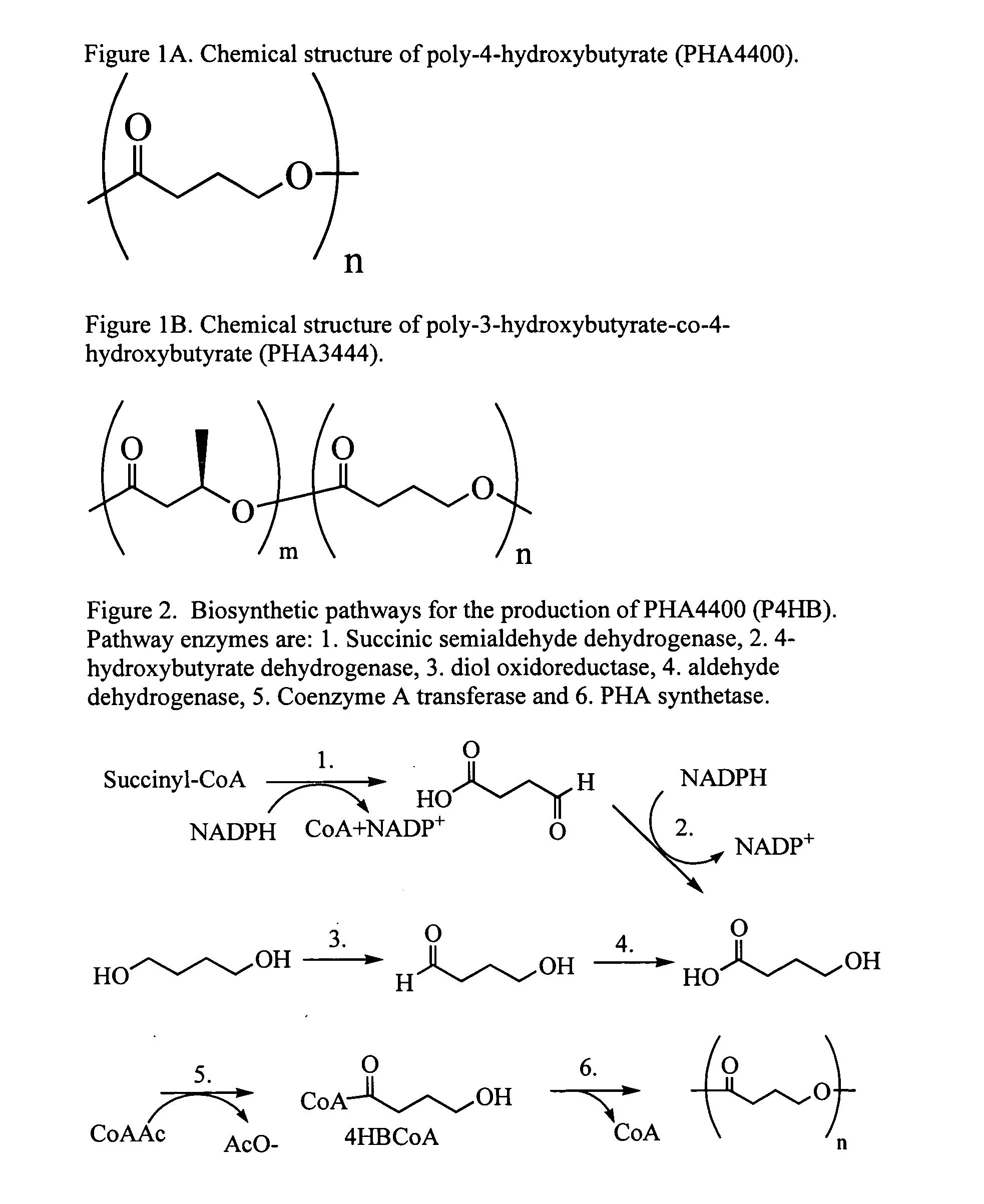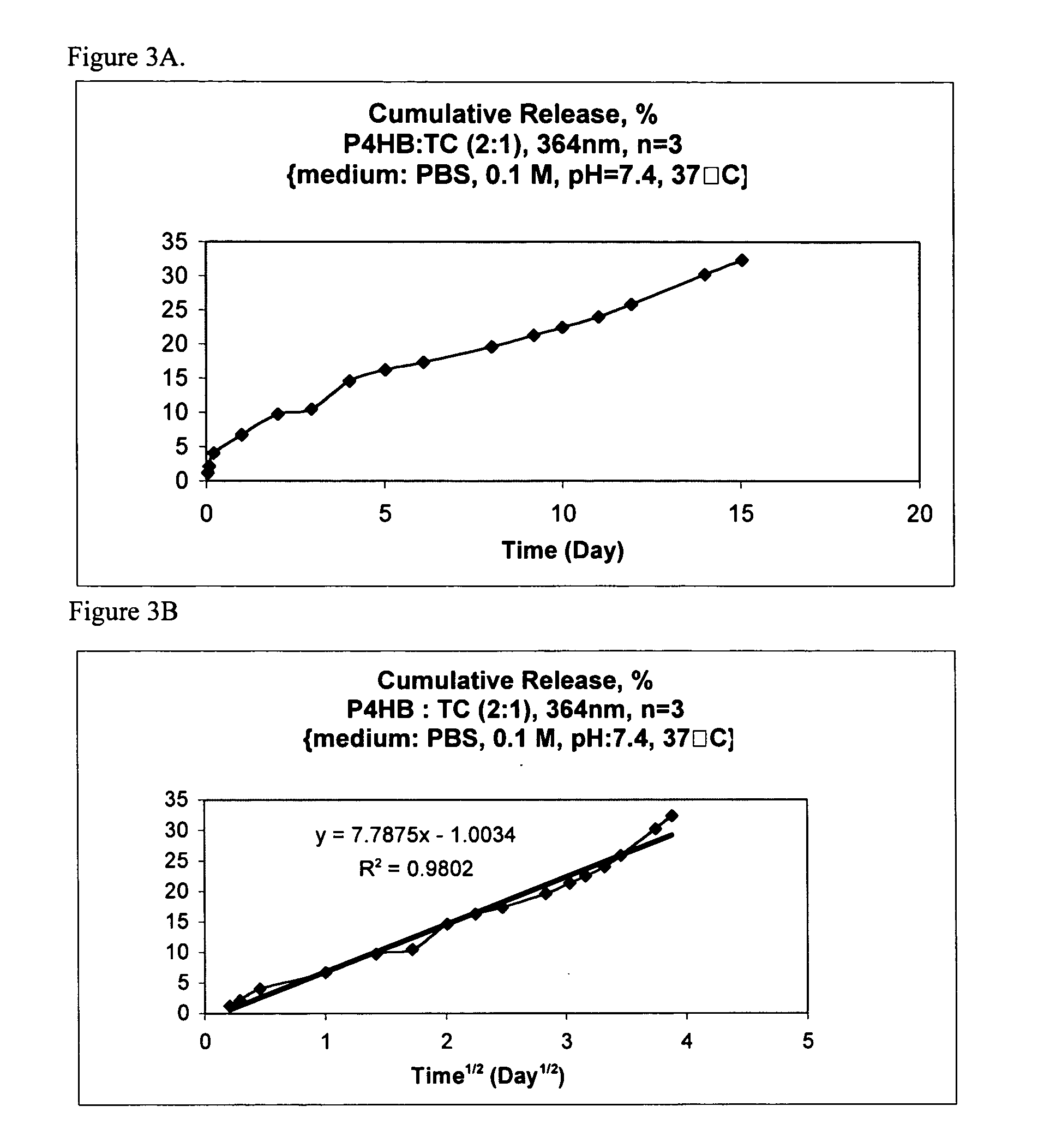Poly-4-hydroxybutyrate matrices for sustained drug delivery
a polyhydroxybutyrate and drug delivery technology, applied in the direction of pharmaceutical delivery mechanism, drug composition, prosthesis, etc., to achieve the effect of reducing the amount of polyhydroxybutyrate, and achieving the desired physical properties, strength, modulus and elongation
- Summary
- Abstract
- Description
- Claims
- Application Information
AI Technical Summary
Problems solved by technology
Method used
Image
Examples
example 1
PHA4400 Rod Preparation
[0047] PHA4400 powder (Tepha, Inc., Cambridge, Mass.) (Mw ˜450 K) was weighed, placed in liquid nitrogen to render it brittle, and ground three times in a blender for 5 s duration. Chloroform was added to the resulting granules until a paste was formed, and then an antibiotic drug was added in a 2:1 ratio of polymer:drug by weight. The paste was then introduced into a mold measuring 150×5×5 mm, and left to dry at ambient temperature. The dry molded formulation was removed from the mold, and sections 2 mm thick were cut yielding rods with approximate dimensions of 2×5×5 mm.
[0048] Rod samples containing two different forms of tetracycline antibiotic were prepared. These were a highly water soluble HCl form, designated TC, and a neutral form, designated TCN (FAKO Pharmaceutical Co., Istanbul). Extinction coefficients for these two forms were determined as 0.117 (μg / mL)−1 at 364 nm for TC and 0.145 (μg / mL)−1 at 357.6 nm for TCN at 37° C. Rods containing 10:1 and...
example 2
Drug Release from PHA4400 Rods
[0049] A rod prepared as described in Example 1 was pre-weighed and introduced into a 50 mL Falcon tube containing 30 mL of 0.1 M pH 7.4 PBS (phosphate buffer). The tube was placed in a shaking water bath and maintained at 37° C. Release of the antibiotic was determined by UV spectrophotometry using the extinction coefficients cited in Example 1 at 4 hours, 24 hours, and then daily with complete replacement of the release buffer with PBS. The release studies were carried out in a minimum of triplicate for each antibiotic.
[0050] The release behavior appeared to follow Higuchi release kinetics (the k values for TC and TCN were 7.79 and 2.62, respectively) for an 11-day period releasing only a fraction of the total content, see FIGS. 3 and 4. TC released at a higher rate than the less water soluble TCN. The average cumulative release of TC at 11 days was approximately 25% versus 9% for TCN, demonstrating long term or sustained release.
[0051] Release fro...
example 3
PHA3444 Rod Preparation
[0053] PHA3444 (34% 44) powder (Tepha, Inc., Cambridge, Mass.) (Mw ˜477 K) was weighed, placed in liquid nitrogen to render it brittle, and ground three times in a blender for 5 s duration. Chloroform was added to the resulting granules until a paste was formed, and then an antibiotic drug was added in a 2:1 ratio of polymer:drug by weight. The paste was then introduced into a mold measuring 150×5×5 mm, and left to dry at ambient temperature. The dry molded formulation was removed from the mold, and sections 2 mm thick were cut yielding rods with approximate dimensions of 2×5×5 mm (as in Example 2).
[0054] Rod samples containing two different forms of tetracycline antibiotic were prepared. These were a highly water soluble HCI form, designated TC, and a neutral form, designated TCN (as above).
PUM
| Property | Measurement | Unit |
|---|---|---|
| thick | aaaaa | aaaaa |
| thick | aaaaa | aaaaa |
| weight | aaaaa | aaaaa |
Abstract
Description
Claims
Application Information
 Login to View More
Login to View More - R&D
- Intellectual Property
- Life Sciences
- Materials
- Tech Scout
- Unparalleled Data Quality
- Higher Quality Content
- 60% Fewer Hallucinations
Browse by: Latest US Patents, China's latest patents, Technical Efficacy Thesaurus, Application Domain, Technology Topic, Popular Technical Reports.
© 2025 PatSnap. All rights reserved.Legal|Privacy policy|Modern Slavery Act Transparency Statement|Sitemap|About US| Contact US: help@patsnap.com



